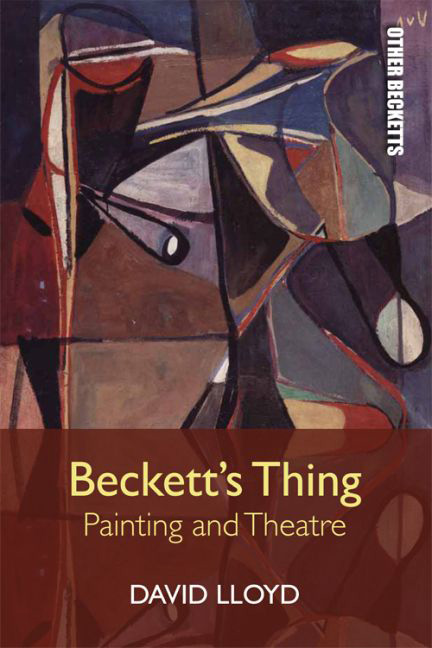Book contents
- Frontmatter
- Contents
- List of Figures
- Acknowledgements
- Other Becketts: Series Preface
- Introduction: The Painted Stage – Beckett's Visual Aesthetics
- 1 Republics of Difference: Yeats, MacGreevy, Beckett
- 2 Beckett's Thing: Bram van Velde and the Gaze
- 3 ‘Siege laid again’: Arikha's Gaze, Beckett's Painted Stage
- Conclusion: The Play's the Thing
- Bibliography
- Index
Conclusion: The Play's the Thing
Published online by Cambridge University Press: 10 May 2017
- Frontmatter
- Contents
- List of Figures
- Acknowledgements
- Other Becketts: Series Preface
- Introduction: The Painted Stage – Beckett's Visual Aesthetics
- 1 Republics of Difference: Yeats, MacGreevy, Beckett
- 2 Beckett's Thing: Bram van Velde and the Gaze
- 3 ‘Siege laid again’: Arikha's Gaze, Beckett's Painted Stage
- Conclusion: The Play's the Thing
- Bibliography
- Index
Summary
The play's the thing
Wherein I'll catch the conscience of the King.
Shakespeare, Hamlet, II, ii, 594–5Among the last three plays that Beckett wrote are two of his most explicitly political works: Catastrophe and What Where. Catastrophe was written in 1982 for the Avignon Festival and, unlike any other of his plays, was dedicated to a specific individual, Václav Havel. Havel, at the time incarcerated for his political activism, was a playwright and a leading figure in the Czech civil society movement. What Where, written and first staged in 1983, and then reconceived for German television in 1986, extends Beckett's enduring concern with scenarios of interrogation and torture that received its most elaborated treatment in the prose text How It Is, at the time of the French debates on torture that were provoked by the Algerian War. What Where explicitly echoes the series of protagonists of that work – Pim, Pom and Pam – in the quartet of characters Bam, Bem, Bim and Bom.1 Indeed, in so far as Catastrophe too stages the spectacle of a person reduced to a captive and manipulable thing, one could say that it participates equally in that strand of Beckett's work. It goes without saying, as many critics have already pointed out, that neither play is solely, maybe not even foremost, concerned with politics: Catastrophe, with its self-important director and stage hands, has been read as an allegory of the playwright's work, for example, while What Where belongs with Beckett's ‘memory plays’ and may also explore the writer's practice – as How It Is had earlier done – as a mode of extorting speech or determining truth, of obliging expression where there is nothing to be expressed and no desire to express.2 It would be surprising if this were not the case: virtually all of Beckett's works condense specific sets of interrelated and overlapping concerns that provide analogies for one another. The resistance to or the difficulty of including politics among those concerns lies not only in Beckett's all-embracing resistance to ‘the craze for explicitation’, as Catastrophe's director puts it, but also in a limited sense of what the concept of the political might entail, given its customary reduction to the advocacy of explicit commitments or the treatment of recognisable ideological positions or debates.
- Type
- Chapter
- Information
- Beckett's ThingPainting and Theatre, pp. 221 - 236Publisher: Edinburgh University PressPrint publication year: 2016



